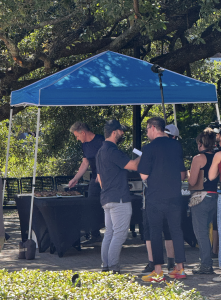Crime in the Crescent City
December 11, 2015
The last thing Jon Vedol expected to happen during his venture into the French Quarter was to be robbed, and it’s an experience he said he will never forget.
“I was terrified because you don’t know what to do. For me it was fight or flight and fighting wasn’t worth it at all,” Vedol said. “It’s going to suck to get everything replaced but it’s more important than losing your life to a weapon.”
Vedol, chemistry junior at Tulane, was walking through the Quarter when a man walked up to him from behind, pushed him against the wall and told Vedol to give him his wallet.
According to CrimeMapping.com, there were 263 armed robberies in the New Orleans area between the dates of June 9, 2015 to
Dec. 6, 2015.
George Capowich, associate professor of criminology, said that in comparison, Uptown has far fewer armed robberies than other neighborhoods such as downtown and the inner-city neighborhoods around the Central Business District.
“What drives robbers to Uptown are those locations where students and residents in the neighborhood are frequenting such places on Carrollton and all the business on Broadway that students like to go to,” Capowich said. “Everyone knows where these locations are. The robbers know that as well.”
According to the Uniform Crime Report, the definition of a robbery is “the taking of anything of value from the care, custody or control of a person by force or threat of force or violence. Robberies committed with a firearm, knife or cutting instrument, implied weapon or other dangerous weapon are considered armed robberies.”
Under the Louisiana judicial system, the maximum sentence for an armed robbery is 99 years in prison, while carjacking is 20 years and simple burglary is 12 years.
Franklyn Scott, assistant professor of criminal justice at Southern University of New Orleans, said that the main reason for crime is poverty.
“I think a lot of people lack the resources that they need. Individuals who have committed crimes and come back after serving time are unable to get jobs like a normal person. Due to their criminal background, they can’t get jobs so they revert to stealing and what they know best,” Scott said.
Scott said that crime is a big problem in New Orleans and that it is hard to control, but one way would be to rehab criminals.
“We need to figure out ways to help convicted felons rehab into society and be law abiding citizens so we can break the circle of crime,” Scott said.
Capowich said that the mindset of a criminal is to steal as much and as quickly as possible.
“There is an intent to at least threaten harm if not actually do harm. I think that these crimes are malicious in that way,” Capowich said. “However, I think it’s a good idea to avoid labels such as evil because those types of labels don’t accurately describe the character of these people.”
According to the New Orleans Uniform Crime Report, from 2010 to 2011, there was a 12.64 percent increase in armed robberies from 704 to 793. From 2011 to 2012, there was a -8.07 percent decrease from 793 to 729. From 2012 to 2013, there was a 2.06 percent increase from 729 to 744, and from 2013 to 2014, there was 37.37 percent increase from 744 to 1022.
Capowich said that guns are a tool that robbers use as a way of controlling their victims.
“Studies have shown that robberies involving a weapon are more threatening because you are less likely to resist. For the most part, they want to use the weapon as a way to intimidate someone to maintain control, get their stuff and leave,” Capowich said.
Angela Honora, Loyola University Police Department lieutenant, said that Loyola does not allow for armed weapons to be allowed on campus or in the residential halls as well as body armor.
Staff and students are not allowed to carry weapons even if they have a concealed weapons permit. Honora said that only LUPD, NOPD or Jefferson Parish police officers are allowed to carry weapons on Loyola’s campus.
“There are signs posted at every entrance to the school. There are definitely spots around New Orleans with higher violence rates as you hear on television, but we try to keep all the violence outside of our campus,” Honora said. “We urge students to report any crime that they witness or hear about to LUPD or NOPD.”
Elmer Johnston, LUPD officer, said the reason for the policy is for student and faculty safety.
“They are having a lot of armed shootings on campuses with active shooters these days. When shots are fired and someone calls in an active shooter we are ordered to respond immediately,” Johnston said. “When we arrive, it becomes a problem if we cannot identify who the active shooter is if you are carrying a gun or wearing body armor.”
Isabelle Benoit, criminal justice senior, is an intern for the public defender’s office in New Orleans and said that she enjoys helping in any way possible the people she hears about in the news.
“The amount of armed robberies that have been in the news lately is alarming, but I don’t think it’s frequency that’s really scaring people. It’s more the fact that they can happen to anyone, anywhere,” Benoit said. “There’s no neighborhood you can avoid, nor is there a neighborhood you can stick to and think you’re safe from harm.
Johnston had several tips for college students’ safety when traveling through the city.
“When you are traveling off-campus, the best advice is to always travel in numbers. There is safety in numbers so always try to be accompanied by friends,” Johnston said. “You also need to know where the hot spots are so you can avoid being there by yourself and becoming a potential victim.”
After his experience with being robbed, Vedol said he used more caution when traveling and even downloaded an app called Rave Guardian to help when going out.
“I used to use the app all the time. I forgot to turn off my safety timer and then NOPD less than thirty seconds later called me two times and then sent a squad car around the corner to check on my last location,” Vedol said.







